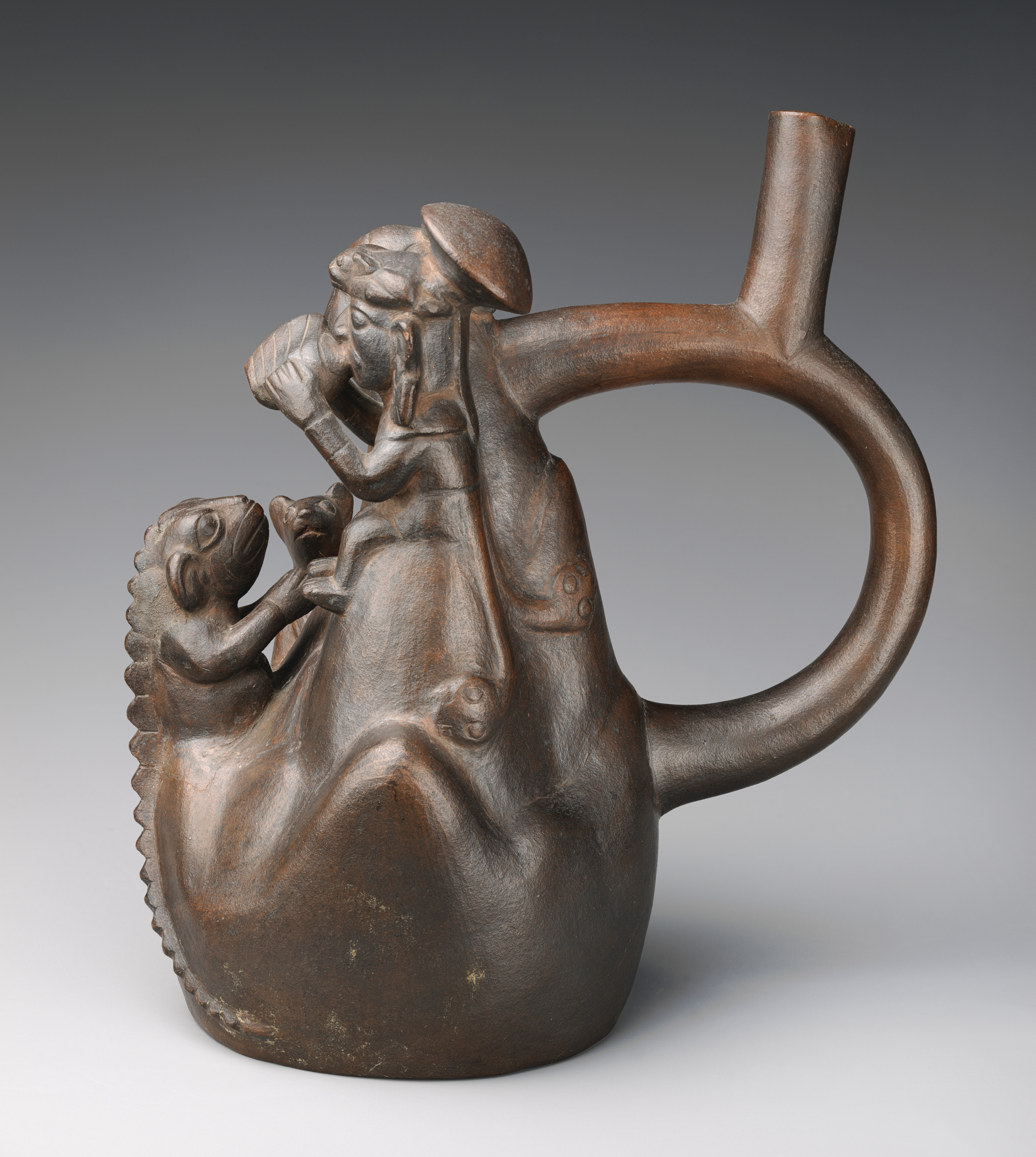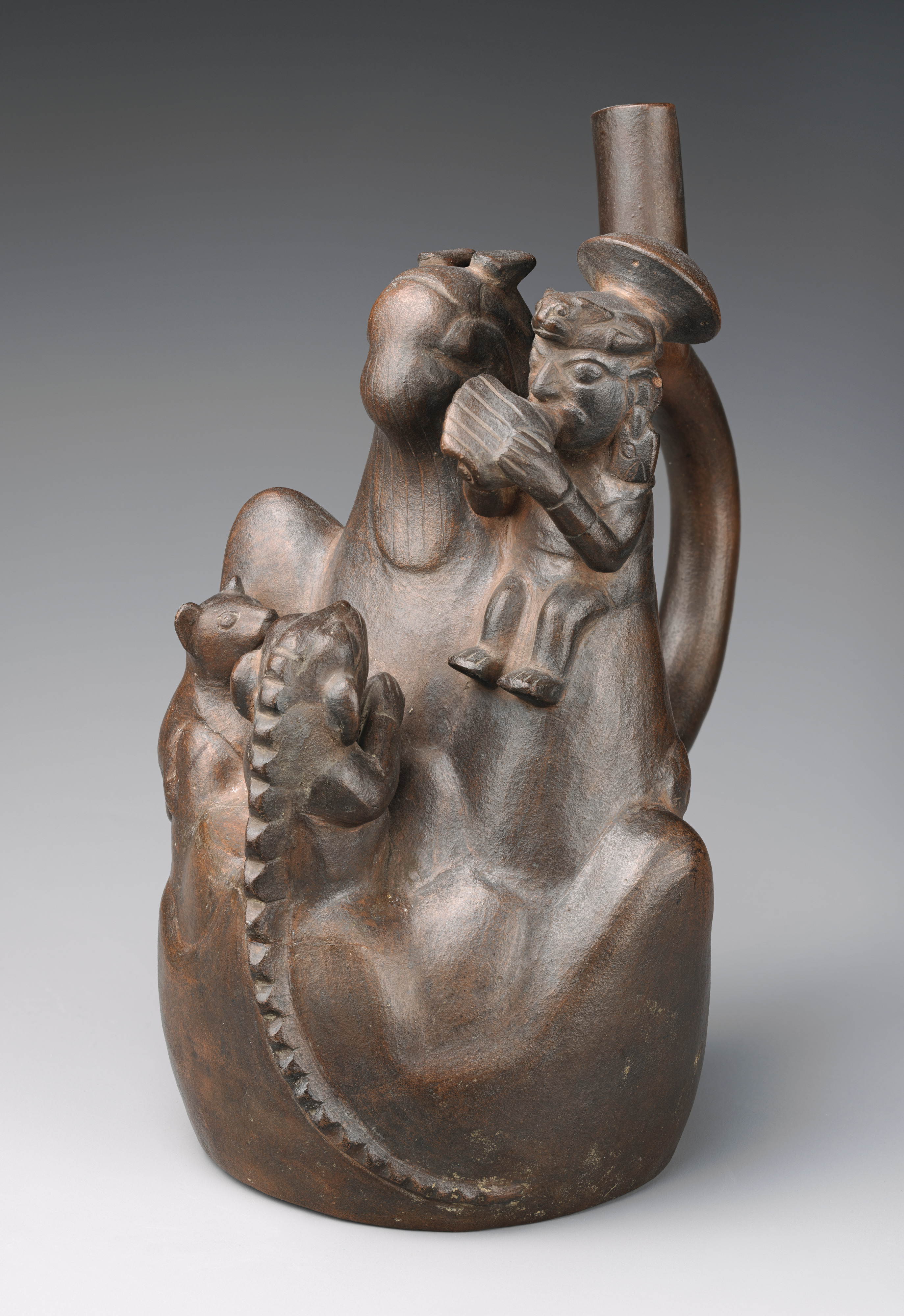Stirrup-spout bottle with mountain sacrifice scene
Not on view
This Moche stirrup-spout bottle was shaped into a five-peak mountain on which humans and animals interact in a sacrifice ritual. The largest figure, located on the second-highest peak, has a human body and wears a feline headdress, snake earrings, and a serpent-headed belt. Often identified as a character known as "Wrinkle Face" (Donnan and McClelland 1999: 64-66), he is a recurrent character in Moche visual narratives (see also MMA 1978.412.70). Commonly shown with an aged face and fangs, here he is depicted playing a trumpet made from a Strombus shell. Next to him, on the highest peak, an apparently lifeless human body lies face down, long hair extending along the slope. No symbols of rank are visible on the body, perhaps an indicator that the figure was taken in combat: headdresses and other items were customarily removed when a war captive was taken in battle. Moche warriors carefully wrapped their heads in cloth and only revealed their hair to the public when they were stripped naked on their way to sacrifice (see, Donnan and McClelland 1999: 76-78).
On the lower half of the bottle, a feline and an iguana wait expectantly. What events might follow are unknown as the stories behind these images have been lost in the remote past. This elaborate scene, however, may have been part of a complex saga of cultural heroes. Different versions of this theme or depictions of other parts of the story can be seen on other works in the Met’s collection (see MMA 67.167.38 and MMA 65.266.88), as well on vessels in museum collections in Lima, Peru (ML003106 at Museo Larco, and C-03300 at Museo Nacional de Arqueología, Antropología e Historia del Perú).
Archaeologists have emphasized the relationship between mountains, temples, and sacrifice in Moche communities (see, among others, Bourget 2016: 25-30). The remains of a prominent mass sacrifice were uncovered at Huaca de la Luna, the most important ceremonial complex in the Moche Valley during this era. This temple, built at the foot of a mountain, includes an enclosure erected around a rocky outcrop. Archaeological excavations revealed the sacrificed bodies of numerous warriors within layers of dried mud, which was interpreted as evidence that this bloody event occurred during moments of environmental perturbation, specifically the periodic catastrophic rains associated with El Niño (Bourget 2001).
Moche civilization flourished on the North Coast of Peru between 200 and 800 CE. Ceramics were used to store and cook food, and they were also used in some of the most important rituals of their time. Elaborate vessels such as the present example were used in elite residences and temples, some to end up as funerary offerings. The bifurcated spout, called a stirrup-spout after its resemblance to that part of a horse’s saddle, was common on the North Coast from the second millennium B.C. until the arrival of the Spaniards in the sixteenth century CE.
Hugo C. Ikehara-Tsukayama, Senior Research Associate, Arts of the Ancient Americas, 2023
References and Further Reading
Bourget, Steve. Sacrifice, Violence, and Ideology Among the Moche. Austin: University of Texas Press, 2016.
Bourget, Steve. "Rituals of Sacrifice: Its Practice at Huaca de la Luna and Its Representation in Moche Iconography," in Moche Art and Archaeology in Ancient Peru, edited by Joanne Pillsbury, pp. 89-109. Washington, D.C.: National Gallery of Art, 2001.
Castillo, Luis Jaime, Cecilia Pardo, and Julio Rucabado. Moche y sus vecinos: Reconstruyendo identidades. Lima: Museo de Arte de Lima, 2016.
Donnan, Christopher and Donna McClelland. Moche Fineline Painting: Its Evolution and Its Artists. Los Angeles: UCLA Fowler Museum of Cultural History, 1999.
Makowski, Krzysztof. "Las divinidades en la iconografía mochica," in Los dioses del antiguo Perú, edited by Krzysztof Makowski, pp. 137-75. Lima: Banco de Crédito del Perú, 2000.
Uceda Castillo, Ricardo Morales Gamarra, and Elías Mujica Barreda. Huaca de la Luna: Templos y dioses moches. Lima: Fundación Backus, World Monuments Fund Peru, 2016.
Due to rights restrictions, this image cannot be enlarged, viewed at full screen, or downloaded.
This artwork is meant to be viewed from right to left. Scroll left to view more.




